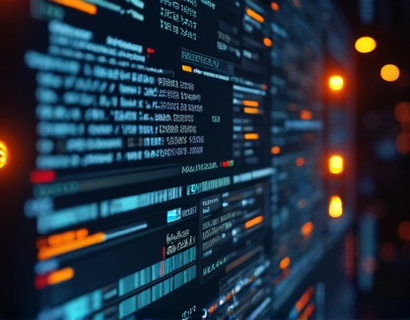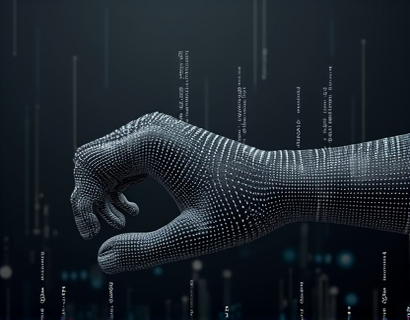Unlocking Enhanced Digital Experiences: Harnessing AI and Crypto for Ucosystem App Engagement
The digital landscape is rapidly evolving, driven by advancements in artificial intelligence (AI) and the rise of cryptocurrency. These two technologies, when combined, offer unprecedented opportunities to enhance user engagement with apps and services. This article delves into the powerful synergy between AI and crypto, exploring how this combination can transform the way we interact with digital platforms, ensuring a seamless and enriched experience in the fast-paced world of digital innovation.
Understanding the Intersection of AI and Cryptocurrency
To fully grasp the potential of AI and crypto in enhancing digital experiences, it's essential to understand the fundamental characteristics of each technology. AI, a branch of computer science, focuses on creating systems that can perform tasks requiring human intelligence, such as learning, reasoning, and problem-solving. On the other hand, cryptocurrency, built on blockchain technology, provides a decentralized and secure means of conducting transactions without the need for intermediaries.
The intersection of AI and cryptocurrency lies in their ability to create transparent, secure, and efficient systems. Blockchain's inherent properties, such as immutability and transparency, align well with AI's need for reliable and trustworthy data. This synergy can lead to the development of apps and services that are not only more secure but also more intuitive and user-friendly.
AI-Powered Personalization in Crypto-Driven Apps
One of the most significant benefits of combining AI and crypto is the ability to offer highly personalized experiences to users. AI algorithms can analyze vast amounts of user data to understand preferences, behaviors, and patterns. In a crypto-driven environment, this data can be securely stored and managed on the blockchain, ensuring privacy and control for the user.
For instance, a crypto-powered app can use AI to tailor content recommendations, financial advice, or even gaming experiences based on individual user profiles. This level of personalization not only enhances user satisfaction but also increases engagement and retention. Users are more likely to interact with an app that understands and caters to their unique needs and preferences.
Enhanced Security Through Blockchain and AI
Security is a paramount concern in the digital world, especially when dealing with sensitive information such as financial data. The combination of AI and blockchain offers robust security measures that can significantly reduce the risk of fraud and data breaches.
AI can be used to detect and prevent anomalous activities in real-time, acting as a proactive defense mechanism. For example, machine learning algorithms can identify patterns that indicate potential fraud and alert the system to take preventive actions. Meanwhile, blockchain's decentralized and cryptographic nature ensures that once data is recorded, it cannot be altered or tampered with, providing an additional layer of security.
Moreover, the use of smart contracts on the blockchain can automate and enforce agreements between parties, reducing the need for intermediaries and minimizing the risk of human error. AI can further optimize the execution of these smart contracts by analyzing conditions and ensuring compliance with predefined rules.
Decentralized Applications (DApps) and User Engagement
Decentralized Applications (DApps) are a prime example of how AI and crypto can collaborate to create engaging and innovative digital experiences. DApps operate on a blockchain network, leveraging the decentralized nature of crypto to provide users with greater control and transparency.
AI can enhance DApps by adding intelligent features such as predictive analytics, natural language processing, and automated decision-making. For instance, a DApp for financial planning can use AI to analyze market trends and provide users with personalized investment recommendations. This not only makes the app more useful but also more engaging, as users can make informed decisions based on real-time data.
Furthermore, the gamification of DApps through AI can significantly boost user engagement. By incorporating elements such as rewards, challenges, and leaderboards, AI can create a more interactive and enjoyable user experience. This approach is particularly effective in crypto-based gaming platforms, where users can earn tokens and cryptocurrencies by completing tasks or participating in games.
Tokenomics and User Incentives
Tokenomics, the study of token economics within blockchain ecosystems, plays a crucial role in enhancing user engagement through AI and crypto. Tokens can be used to incentivize users to participate actively in a DApp or service. AI can optimize the distribution and utilization of these tokens to maximize user engagement and retention.
For example, an AI-driven system can analyze user behavior to determine the most effective reward structures. It can adjust token distributions based on user activity, ensuring that the most engaged users receive the most benefits. This dynamic approach keeps users motivated and encourages continuous interaction with the app or service.
Additionally, AI can help in designing tokens with specific utility and scarcity, which can enhance their value and appeal. By understanding market dynamics and user preferences, AI can suggest token designs that resonate with the target audience, further driving engagement.
Scalability and Interoperability
As the number of crypto-based apps and services grows, scalability and interoperability become critical challenges. AI can play a vital role in addressing these issues, ensuring that the digital ecosystem remains efficient and user-friendly.
AI-driven algorithms can optimize blockchain networks to handle increased transaction volumes without compromising speed or security. Techniques such as sharding and layer 2 solutions can be fine-tuned using AI to improve scalability. Moreover, AI can facilitate interoperability between different blockchain platforms, allowing seamless interaction and data exchange between various DApps and services.
This interoperability is essential for creating a cohesive digital ecosystem where users can seamlessly switch between different apps and services. AI ensures that this process is smooth and efficient, enhancing the overall user experience.
Future Trends and Innovations
The integration of AI and crypto is still in its early stages, and the future holds numerous exciting possibilities. One emerging trend is the development of AI-powered decentralized autonomous organizations (DAOs). These organizations use smart contracts and AI to make collective decisions, manage resources, and execute projects in a transparent and democratic manner.
Another area of innovation is the use of AI in enhancing the user interface (UI) and user experience (UX) of crypto-driven apps. AI can analyze user interactions to identify pain points and suggest improvements, leading to more intuitive and user-friendly designs. Additionally, AI-driven voice assistants and chatbots can provide users with hands-free and conversational interactions, making the app more accessible and convenient to use.
The convergence of AI and crypto also opens up new opportunities in the realm of decentralized finance (DeFi). AI can optimize DeFi protocols by analyzing market data, predicting price movements, and automating trading strategies. This can make DeFi more accessible and appealing to a broader audience, further driving adoption and engagement.
Conclusion
The combination of AI and crypto represents a transformative force in the digital world, offering unparalleled opportunities to enhance user engagement with apps and services. By leveraging the strengths of both technologies, developers can create secure, personalized, and innovative digital experiences that meet the evolving needs of users.
As the landscape continues to evolve, it is crucial for tech-savvy individuals and organizations to stay informed and adapt to these changes. Embracing the synergy between AI and crypto can lead to groundbreaking solutions that redefine how we interact with the digital world.










































